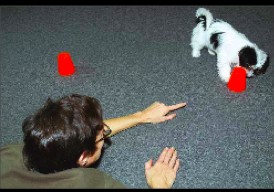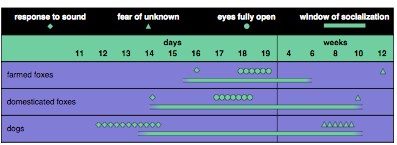Tameability and Domestication
Bio 342 By Alex Winters
Ontogeny
Critical periods
Belyaev and Trut found in their farm-fox experiment that critical period changes could be seen in sight, hearing, fear response, and bonding (Figure from Trut 1999).
Implictions for the evolution of dogs
Researchers posit that similar changes probably occurred in the evolution of dogs. Animal that could better bond with humans may have been selected for by the environment or by artificial selection. A longer socialization period could have led to more dogs being tamed.
Example: Object permanence (Hare & Tomasello, 2005)
The task consists of understanding that something which is out of sight still exists. Dogs also perform well on this task, a surprising finding as other non-human primates such as the chimpanzee (the closest human relative) do not do well in this type of evaluation. What’s more, dogs are able to use the actions of humans to aid them in the uncovering of hidden objects. When an experimenter points, stares, or uses a novel cue (such as block marker) to delineate where a treat is hidden, dogs, even puppies, can use these interspecies cues to find the treat. What’s more, dog can tell the difference between different human social cues. If an experimenter stands closer to one hiding spot but looks at another or turns their head towards one but fixes their eyes elsewhere, dogs interpret these signals only in terms of gaze. This ability of dogs to use human social cues appears early in life and are robust in all breeds and in dogs raised with and without human attention.
Convergent evolution
Some researchers have suggested that this may have been cause by convergent evolution between dog and man. One idea is that this might take the form of predisposition of certain animals to be able to absorb human signals during rearing with humans. This could explain why some chimps (those raised by humans) perform significantly better than others in tests of using human cues to find hidden objects. But this does not bear out in dog studies.
- First, young puppies show this effect just as robustly as older dogs. (See figure).
- Second, there does not appear to be any difference in dogs raised with humans (in a home, with a trainer, etc) and those raised with other dogs (shelters) in terms of social cue reading. (Hare & Tomasello, 2005)
